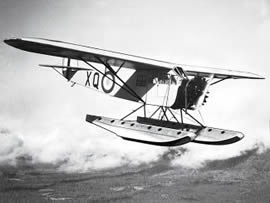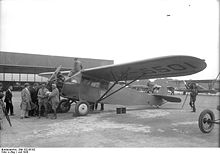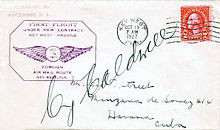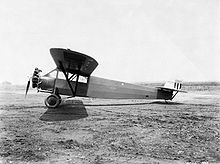Fairchild FC-2 Video - Picture

|
|
Fairchild FC-2
FC-1, FC-2, and Models 51 and 61

Picture - RCAF FC-2L "Razorback"
Role: Civil utility aircraft
Manufacturer: Fairchild, Canadian Vickers under license
Designed by: Alexander Klemin and Norman McQueen
First flight: 14 June 1926
Number built: ca. 180
The Fairchild FC-1 and its derivatives were a family of light, single engine, high wing utility monoplanes produced in the United States in the 1920s and 1930s. The aircraft was originally designed to provide a camera platform for Sherman Fairchild's aerial photography and survey business, Fairchild Aerial Surveys.
Design and development
Fairchild had approached a number of aircraft builders with specifications for what he considered to be an ideal aircraft for this type of work, with which he hoped to replace the variety of types that his firm then operated. Believing the quotes he received to be excessive, Fairchild opted to produce the aircraft in-house, purchasing facilities at Farmingdale, New York for the purpose. The design was for a conventional high-wing, strut-braced monoplane with fully enclosed cabin and tailwheel undercarriage. To facilitate its intended role, the cabin was extensively glazed, offering plenty of vantage points for photographers.
The prototype FC-1 flew in June 1926, and initial testing found its original Curtiss OX-5 engine to be inadequate. A Wright J-4 with double the horsepower was soon substituted and the aircraft was redesignated FC-1A. This was felt to have commercial potential, and in a slightly revised form, was put into production as the FC-2.
Operational history

Picture - The FC-2W of Collyer and Mears at Berlin in 1928
The production aircraft differed from the prototype in having increased cabin volume, and was offered with a choice of powerplants. Other options included a choice of wheeled, ski, or float undercarriage. Early production aircraft fitted with only three longerons in the rear fuselage gave this batch of aircraft a "Razorback" appearance leading to its nickname. Later production series eliminated this distinctive feature.
A version optimized for cargo carrying was produced as the FC-2W with a Pratt & Whitney Wasp radial engine and increased wingspan. Two of this latter version were destined for fame: City of New York, flown by Charles Collyer and John Mears for the overland portions of their record-breaking around-the-world trip in June-July 1928, and Stars and Stripes, an FC-2W2 taken by Richard Evelyn Byrd on his Antarctic expedition of the same year. Byrd's aircraft is preserved at the Virginia Aviation Museum.
FC-2Ws were also prominently used in the 1928 rescue of the crew of the aircraft Bremen in Canada.

Picture - Cover carried in the Fairchild FC-2 "La Nix±a" on the first southbound flight of FAM-4 (The Cooper Collections)
On 19 October 1927, an FC-2 configured as a floatplane made the first contract Air Mail flight operated by Pan American Airways. When unable to begin its service over Foreign Air Mail Route #4 (FAM-4) between Key West, Florida, and Havana, Cuba, on that date (as required under its contract) because heavy rains had delayed completion of the new runway at Key West needed to accommodate the company's Fokker F.VIIa/3m type tri-motor transports, PAA chartered (cost: $145.45) the FC-2 La Nix±a (NC-1654, c/n 15)[1] piloted by Cy Caldwell and belonging to West Indian Aerial Express, a company which would be acquired by Pan Am a year later. Pan American was finally able to inaugurate daily service over the route nine days later with the Fokker F.VIIa/3m General Machado (NC-53).
Due to a Royal Canadian Air Force requirement to standardize engines, the basic FC-2 design was re-engineered with a 215 hp Armstrong Siddeley Lynx radial engine and redesignated as the FC-2L. In this form, the type flew with RCAF units, primarily in northern operations.
The Model 51 was a modernized version of the FC-2 produced in 1930 to compete with new transports in the marketplace, the most significant single change being the fitting of a more powerful Wright J-6 engine again. A few examples were converted from FC-2s. The Model 61 also had the J-6 engine, but included a redesigned cabin to add another two passenger seats. Only three of these were built, modified from FC-2W2s, but the cabin modification was retained in the Model 71.
Variants

Picture - Fairchild FC-2W2
FC-1 - prototype with Curtiss OX-5 engine (1 built)
FC-1A - prototype modified with Wright J-4 engine (1 converted)
FC-2 - production version with Wright J-5 engine (118 built, plus 12 built by Canadian Vickers under license)
FC-2C (for "Challenger") - version with Curtiss Challenger engine for Curtiss Flying Service (6 built)
FC-2L (for "Lynx") - version with Armstrong Siddeley Lynx engine for Royal Canadian Air Force (3 converted)
FC-2W (for "Wasp") - version with Pratt & Whitney Wasp engine (14 built)
FC-2W2 - definitive production version of FC-2W
UC-96 - designation given to three FC-2Ws impressed into USAAF service
Model 61 - FC-2W2s with enlarged cabin (3 converted)
Model 51 - FC-2s refitted with Wright J-6 engine (31 built)
XJQ-1 (later RQ-2) - single FC-2 purchased by United States Navy for evaluation. Redesignated XJQ-2, later redesignated again as the XRQ-2.
Operators
Canada
Royal Canadian Air Force
Chile
Lxnea Aeropostal Santiago-Arica(LAN Chile)
United States
Pan American Airways
Specifications (FC-2)
General characteristics
Crew: One pilot
Capacity: four passengers or 820 lb (372 kg) freight
Length: 31 ft 0 in (9.45 m)
Wingspan: 44 ft 0 in (13.41 m)
Height: 9 ft 0 in (2.74 m)
Wing area: 290 ft² (26.9 m²)
Empty weight: 2,160 lb (980 kg)
Gross weight: 3,600 lb (1,633 kg)
Powerplant: 1 x— Wright J-5, 200 hp (149 kW)
Performance
Maximum speed: 122 mph (196 km/h)
Range: 700 miles (1,127 km)
Service ceiling: 11,500 ft (3,500 m)
Rate of climb: 565 ft/min (2.9 m/s)
Bibliography
Milberry, Larry. Aviation In Canada. Toronto: McGraw-Hill Ryerson Ltd., 1979. ISBN 0-07-082778-8.
Molson, Ken M. and Taylor, Harold A. Canadian Aircraft Since 1909. Stittsville, Ontario: Canada's Wings, Inc., 1982. ISBN 0-920002-11-0.
Taylor, Michael J.H. Jane's Encyclopedia of Aviation. London: Studio Editions, 1989, p. 353. ISBN 0-51710-316-8.
World Aircraft Information Files. London: Bright Star Publishing, File 894 Sheet 03.
Fairchild FC-2 Pictures
More aircraft.
Source: WikiPedia